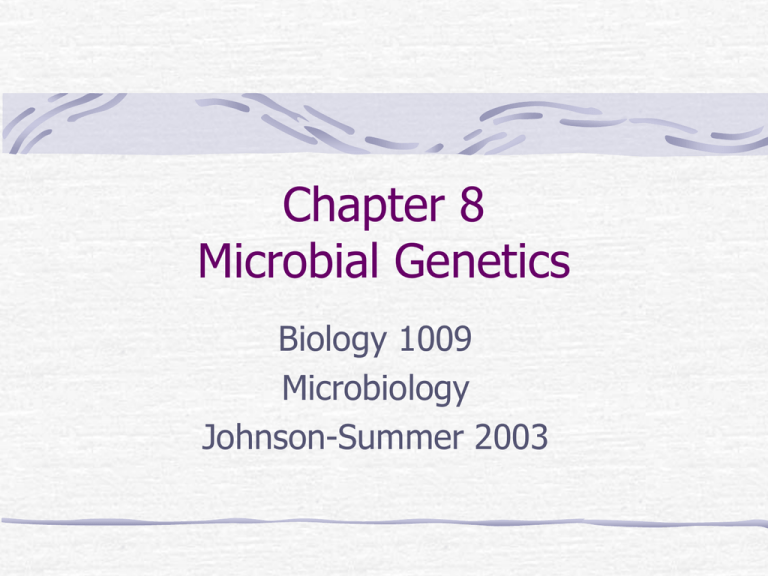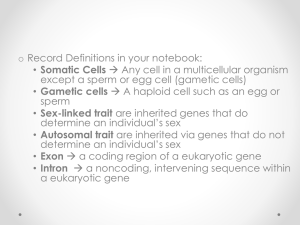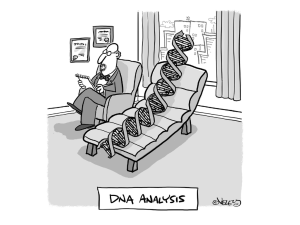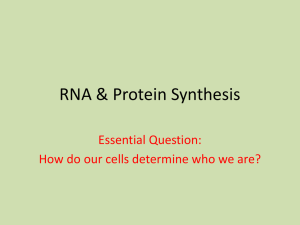Chapter 8 Microbial Genetics
advertisement

Chapter 8 Microbial Genetics Biology 1009 Microbiology Johnson-Summer 2003 Structure and Function of Genetic Material DNA & RNA DNA=deoxyribonucleic acid RNA=ribonucleic acid Basic building blocks: Nucleotides Phosphate group Pentose sugar Nitrogenous base Structure of DNA Double stranded (double helix) Chains of nucleotides 5’ to 3’ (strands are anti-parallel) Complimentary base pairing A-T G-C DNA Structure Phosphate-P Sugar-blue Bases-ATGC DNA Replication Bacteria have closed, circular DNA Genome: genetic material in an organism E. coli 4 million base pairs 1 mm long (over 1000 times larger that actual bacterial cell) DNA takes up around 10% of cell volume DNA Replication-occurs at the replication fork 5’ to 3 ‘ DNA helicase-unzips + parental DNA strand that is used as a template Leading stand (5’ to 3’-continuous) *DNA polymerase-joins growing DNA strand after nucleotides are aligned (complimentary) Lagging strand (5’ to 3’-not continuous) *RNA polymerase (makes short RNA primer) *DNA polymerase (extends RNA primer then digests RNA primer and replaces it with DNA) *DNA ligase (seals Okazaki fragments-the newly formed DNA fragments) Replication Fork Protein Synthesis DNA------- mRNA------ protein transcription translation Central Dogma of Molecular Genetics Transcription One strand of DNA used as a template to make a complimentary strand of mRNA Promoter/RNA polymerase/termination site/5’ to 3’ Ways in which RNA & DNA differ: RNA is ss RNA sugar is ribose Base pairing-A-U Transcription Types of RNA Three types: mRNA: messenger RNA Contains 3 bases ( codon) rRNA: ribosomal RNA Comprises the 70 S ribosome tRNA: transfer RNA Transfers amino acids to ribosomes for protein synthesis Contains the anticodon (3 base sequence that is complimentary to codon on mRNA) Genetic Code DNA: triplet code mRNA: codon (complimentary to triplet code of DNA) tRNA: anticodon (complimentary to codon) Genetic Code Codons: code for the production of a specific amino acid 20 amino acids 3 base code Degenerative: more than 1 codon codes for an amino acid Universal: in all living organisms Genetic Code Translation Three parts: Initiation-start codon (AUG) Elongation-ribosome moves along mRNA Termination: stop codon reached/polypeptide released and new protein forms rRNA=subunits that form the 70 S ribosomes (protein synthesis occurs here) tRNA=transfers amino acids to ribosomes for protein synthesis) Mutations Changes in base sequence of DNA/lethal and inheritable Can be: Harmful Lethal Helpful Silent Normal DNA/Missense Mutation Nonsense Mutation/Frameshift Mutation Genetic Transfer in Bacteria Genetic transfer-results in genetic variation Genetic variation-needed for evolution Three ways: Transformation: genes transferred from one bacterium to another as “naked” DNA Conjugation: plasmids transferred 1 bacteria to another via a pilus Transduction: DNA transferred from 1 bacteria to another by a virus Transduction by a Bacteriophage Transformation Conjugation in E. coli Conjugation continued… Conjugation continued…











